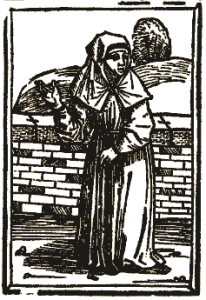The Female Body
Relics
Caroline Walker Bynum’s Fragmentation and Redemption: Essays on Gender and the Human Body in Medieval Religion explores the grotesque image of the body, especially the portrayal of the female body in the Middle Ages. Bynum points out that the body is considered as a “medieval enthusiasm for body as means of religious access remains prominent in modern Catholic Europe: the cult of relics” [1]. These relics are not only a representation of Christianity but they were also “saints themselves” [2]. In relation to the process, she has a brooch and on it an insignia that reads “love conquers all” [3]. Although this is a positive message that implies love will perish evil, especially because it is included with her rosary, it is rather odd for a nun to carry such a golden brooch. Regarding this, the gold jewelry and the insignia implies her materialistic tendencies and ideal philosophy, respectively. In relation, the insignia can be interpreted as Bynum emphasizes the medieval act of women sacrificing their bodies to unify with the body of Jesus: “Starving her body into submission, the Italian tertiary Angela of Foligno spoke of encounter with Jesus as “love and inestimable satiety, which, although it satiated, generated at the same time insatiable hunger, so that all her members were unstrung.” [4] In regards to the “Prioress’ Tale,” the grotesque death of the boy allowed him to move closer to God.

Furthermore, Bynum also notes that blood is a cleansing agent: “the shedding of blood or cleansed those who shed it. Indeed, bleeding was held to be necessary for the washing away of superfluity, so much so that physiologists sometimes spoke of males as “menstruating.””[5] Likewise, the child’s gruesome death and blood gushing out of his slit throat is somehow cleansing, especially since he could somehow still sing and a “white lamb celestial” is mentioned. Lambs are symbols of sacrifice in the Old Testament, meaning that they must be killed in order to take their blood and use it as a ward against evil. Hence the boy becomes that symbol of something gruesome (his death), being cleansed as he is saved by the Virgin Mary.
Male and Female / The Body and Soul
In Fragmentation and Redemption, Bynum claims medieval people were able to mix categories regarding the spiritual, physical, and the male and female sexes with ease because theology and philosophy often combined the body with the soul. Unlike contemporary religious ideas which claim that the body and soul are separate, Bynum suggests that medieval people considered them only to be able to work together to make a human being. To experience spirituality was to be demonstrative with the body. Bynum states that female spirituality was especially related to the body. Although there were less female saints than men, religious women were experiencing illness and suffering more often than men. While men did experience bodily occurrences, women described them more personally. Women did not distinguish whether these experiences appealed to the physical senses or the soul.


Bynum explores women’s somatic devoutness in two sets: the relationship between the male and female bodies and the relationship between the body and soul. She explains there were traditions which conditioned both men and women to expect women to be more expressive of their bodies than men, whether it be sexually or maternally. Medieval people also associated the body of Christ with the female body because His body could nurse, feed and bleed.
Medieval thinkers used gendered images interchangeably when depicting religious figures. Medieval interpreters saw that a woman to a man is like the body to the spirit. The woman represents Christ’s humanity and the man His divinity. Bynum comments on these relationships to demonstrate the disconnect from the modern concept of spirituality and feelings of the flesh being separated with the medieval theologies which made these relationships associated with each other. Many theologians during the thirteenth and fourteenth centuries argued whether resurrection was natural after the Last Judgement, rather than a divine miracle, because God created the body and the soul as a unit. Thirteenth-century philosopher Thomas Aquinas uses a hylomorphic analysis (Aristotle’s theory where the soul gives form to the matter that is the body) to explain that a soul can outlive the body’s death, but the whole person cannot exist until the body is restored upon Judgement Day.
[1] Bynum, Fragmentation and Redemption, 183
[2] Ibid., 183
[3] Chaucer, Canterbury Tales, VII.160-162
[4] Bynum, Fragmentation and Redemption, 184-185
[5] Ibid., 215
[6] Bynum, Fragmentation and Redemption, 191